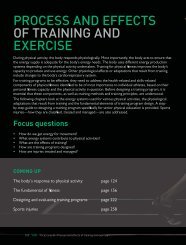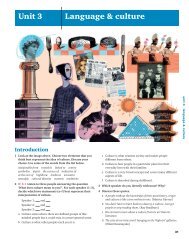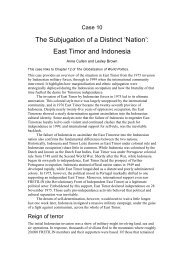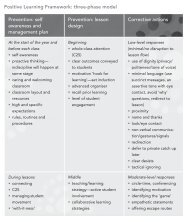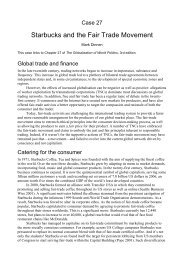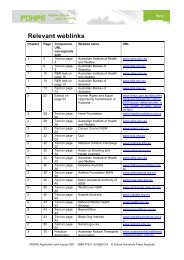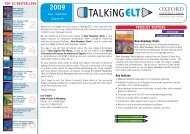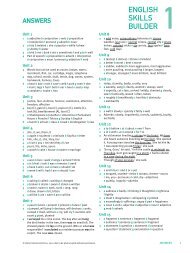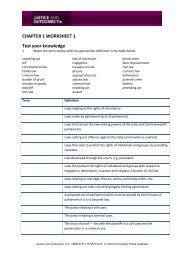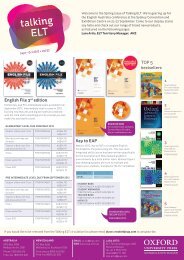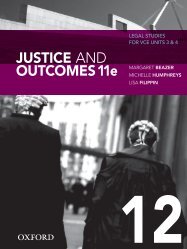did you know?
did you know?
did you know?
Create successful ePaper yourself
Turn your PDF publications into a flip-book with our unique Google optimized e-Paper software.
chapter 6>><br />
visual perception<br />
POSSIBLY THE BEST ILLUSTRATION OF THE WAY BODY AND MIND<br />
INTERACT TO ENABLE US TO PERCEIVE THE WORLD AROUND US IS IN<br />
THE PROCESS OF VISION. OUR EYES RECEIVE THE STIMULUS ENERGY<br />
OF LIGHT, REFLECTED FROM AN OBJECT IN THE OUTSIDE WORLD,<br />
LIGHT-SENSITIVE CELLS IN THE EYE SEND MESSAGES TO THE BRAIN<br />
AND THEN WE INTERPRET AND UNDERSTAND WHAT WE SEE.
six stages of visual perception<br />
>>key <strong>know</strong>ledge>><br />
Application of psychological perspectives to explain<br />
visual perception:<br />
> characteristics of the visual perceptual system and<br />
the visual processes involved in detecting and<br />
interpreting visual stimuli<br />
> the effect of psychological factors on perceptual set<br />
> distortions of visual perceptions by illusions.<br />
(VCE Study Design 2009)<br />
A study of the way in which we perceive the world around<br />
us through the sense of vision is a wonderful example of the<br />
way the brain and body work together, depend on each other<br />
and help each other as we go about our everyday activities.<br />
One of the key objectives of this chapter is to help<br />
<strong>you</strong> to understand how the physical reality of light from<br />
the object in the environment—referred to as the distal<br />
stimulus—is cast as an image on the retina—called the<br />
proximal stimulus—and nerve impulses travel to the brain<br />
where higher mental processes enable us to organise and<br />
interpret what we see.<br />
fig 6.1>> The eye<br />
>>chapter overview>><br />
Six stages<br />
of visual<br />
perception<br />
The processes<br />
of visual<br />
perception<br />
The principles<br />
of visual<br />
perception<br />
Distortions of<br />
perception<br />
> Reception<br />
> Transduction<br />
> Transmission<br />
> Selection<br />
> Organisation<br />
> Interpretation<br />
Reception and light energy<br />
Reception and absolute threshold<br />
The role of the eye in visual perception<br />
Selection and organisation of visual<br />
stimuli<br />
> Perceptual constancies<br />
> Size constancy<br />
> Shape constancy<br />
Gestalt principles of perceptual<br />
organisation<br />
> The phi phenomenon<br />
> Figure-ground organisation<br />
> Camouflage<br />
> Closure<br />
> Similarity<br />
> Proximity<br />
Depth perception<br />
> Binocular depth cues<br />
> Retinal disparity<br />
> Convergence<br />
> Monocular depth cues<br />
> Accommodation<br />
> Pictorial depth cues<br />
> Linear perspective<br />
> Interposition<br />
> Texture gradient<br />
> Relative size<br />
> Height in the visual field<br />
The effect of psychological factors on<br />
perceptual set<br />
The Ponzo Illusion<br />
The Müller-Lyer Illusion<br />
> The carpentered world hypothesis<br />
> The perceptual compromise<br />
theory<br />
The Ames Room Illusion<br />
111
chapter 6>> visual perception<br />
The actual image on our retina is:<br />
> upside-down<br />
> back-to-front<br />
> blurred<br />
> crisscrossed by a network of veins<br />
> patched by holes.<br />
Yet when this image has been sent to the brain, it<br />
is processed so that we see a crystal-clear picture! The<br />
process itself—from receiving an image to ultimately<br />
interpreting what we see—is complex and has been studied<br />
extensively by a number of psychological perspectives as<br />
discussed in Chapter 5.<br />
The processes involved in sensation and perception<br />
are also thought to be adaptive. From an evolutionary<br />
perspective, the ability to see, hear, touch, smell and<br />
taste has developed over thousands of years and through<br />
millions of changes—leaving our senses perfectly suited<br />
to our environment and to help us survive and reproduce<br />
(Tooby & Cosmides 1992, cited in Westen et al. 2009). Just<br />
like frogs, which have an inbuilt ‘bug-detecting’ function<br />
in their visual system designed to activate when a tasty<br />
insect is in view, humans have specialised areas in the brain<br />
that allow the perception of faces and facial expression.<br />
This can be seen in infants, who have an innate or inborn<br />
tendency to show greater interest in objects that look like a<br />
human face (Adophs, Damasio, Tranel & Damasio 1996).<br />
The eye is a fantastic organ—it is very complex in<br />
construction, but we only need to <strong>know</strong> about a few of its<br />
structures.<br />
fig 6.2>> Movement of light entering eye<br />
112<br />
From the time we receive an image to when we can<br />
identify what we see, six stages have been identified, some<br />
of which occur at about the same time. Essentially these<br />
six stages progress, in sequence, from being reflexive<br />
physical functions of the eye and nervous system to being<br />
psychological functions of the brain, involving memory<br />
and thought processes.<br />
sensation and<br />
perception<br />
1 Reception: Light enters the eye through the cornea,<br />
a tough transparent tissue covering the front of the<br />
eye. It then passes through the pupil—the hole in<br />
the middle of the coloured part of the eye (the iris).<br />
The lens then focuses the light on the retina, which<br />
contains the photoreceptors—light-sensitive cells called<br />
rods and cones.<br />
2 Transduction: The electro-magnetic energy that we<br />
<strong>know</strong> as light energy is converted by the rods and cones<br />
into electro-chemical nerve impulses. This allows the<br />
visual information to travel along the fibres of the optic<br />
nerve to the brain.<br />
3 Transmission: The next task for the rods and cones<br />
is to send the nerve impulses along the optic nerve to<br />
the primary visual cortex in the occipital lobes, at the<br />
very back of the brain where specialised receptor cells<br />
respond as the process of visual perception continues.
fig 6.3>> The brain makes sense of what we see.<br />
4 Selection: We can’t possibly pay attention to all the<br />
millions of stimuli that enter the eye at the same time,<br />
so we pick out the ones that are important to us and<br />
pay attention to those. At this stage of the process, the<br />
image is broken up by specialised cells called feature<br />
detectors. Feature detectors are cells that individually<br />
respond to lines of a certain length, lines at a certain<br />
angle or lines moving in a certain direction. Feature<br />
detector cells are found in the optic nerve and in the<br />
primary visual cortex.<br />
5 Organisation: When visual information reaches the<br />
brain (visual cortex), it is reorganised so that we can<br />
make sense of it. We do this by using certain visual<br />
perceptual principles:<br />
> perceptual constancies<br />
> Gestalt principles<br />
> depth and distance cues<br />
These are explained in the next section of this<br />
chapter.<br />
Once the image is reassembled using these principles,<br />
it travels along two pathways simultaneously: to the<br />
temporal lobe, to identify the object, and to the parietal<br />
lobe, to judge where the object is in space (in relation to<br />
our visual field and ourselves).<br />
6 Interpretation: This is the process whereby the visual<br />
stimulus/object is given meaning. The temporal lobes<br />
identify what the object is by comparing incoming<br />
information with information already stored in memory.<br />
Past experience, motives, values and context help us<br />
understand what we are looking at by contributing to<br />
our perceptual set (as discussed later in this chapter).<br />
At the same time as information is sent to the temporal<br />
fig 6.4>> Do <strong>you</strong> <strong>know</strong> why a person cannot see clearly<br />
underwater? The cornea of the eye is designed to refract or bend<br />
light rays travelling through the air—not through water. So when<br />
<strong>you</strong> put on swimming goggles or a diving mask, the layer of air<br />
between the water and cornea allows <strong>you</strong> to see more clearly.<br />
lobes, it also travels to the parietal lobes, which assist in<br />
judging where the object is in space (in relation to our<br />
visual field and us).<br />
Patients who have damage or tumours in parts of<br />
the temporal lobe responsible for identifying a visual<br />
stimulus may be unable to recognise an object or a<br />
familiar face (prosopagnosia). Patients who have damage<br />
to the parietal lobe will be able to recognise an object but<br />
may constantly bump into furniture or misjudge picking<br />
up their knife and fork.<br />
113
chapter 6>> visual perception<br />
Wavelength in<br />
nanometres<br />
Wavelength in<br />
metres<br />
review 6.1<br />
Copy this table into <strong>you</strong>r workbook or use a computer. Complete the table using the information<br />
provided for each stage of the visual perception process. (Note that the image prior to entering<br />
the eye during the reception stage is the correct way up but by the time it reaches the retina, it has<br />
been turned upside down and back to front.)<br />
Gamma<br />
rays<br />
Reception Transduction Transmission Selection Organisation Interpretation<br />
the processes of visual<br />
perception<br />
reception and light energy<br />
The process of light entering the eye is an important part of our ability to receive and interpret<br />
a visual stimulus. However, before the eye can receive the visual stimulus, there are a couple of<br />
elements that must be in place.<br />
First, the light energy must be within the visible part of the electromagnetic spectrum.<br />
Wavelengths of between 360 and 760 nanometres form the visible spectrum (1nm = 1 billionth<br />
of a metre). The energy that enables us to see is what we call light energy, the visible part of the<br />
electromagnetic spectrum.<br />
400 500 600 700<br />
The Visible Spectrum<br />
Ultra-<br />
Infrared<br />
X-rays violet<br />
Radar<br />
rays<br />
rays<br />
Wavelength in nanometres<br />
400 500 600 700<br />
Perceived colour<br />
FM Television<br />
Short<br />
wave<br />
Radio waves<br />
Broadcast<br />
bands<br />
10 – 12 10 – 10 10 – 8 10 – 6 10 – 4 10 – 2 102 1 104 106 fig 6.5>> Electromagnetic spectrum, including the visible spectrum<br />
114<br />
Violet<br />
Indigo<br />
Blue<br />
Green<br />
Yellow<br />
Orange<br />
Red<br />
AC circuits
eception and absolute<br />
threshold<br />
The second important element in the eye detecting the light stimulus is that<br />
the light energy that falls within the visible light spectrum must be intense<br />
enough for the human eye to see. In other words, it must reach absolute<br />
threshold. The absolute threshold is the minimum amount of light energy<br />
needed for an observer to perceive a stimulus, in ideal conditions, 50 per cent<br />
of the time.<br />
One method psychologists use to measure absolute threshold is by<br />
presenting light stimuli at different intensities to see what level of intensity<br />
is needed for a person to detect the light. If that person detects it during the<br />
experiment about 50 per cent of the time at a particular intensity (the point<br />
at which they actually perceive it), then absolute threshold has been reached.<br />
Absolute threshold for the senses are:<br />
> Hearing: ticking of a watch six metres away.<br />
> Smell: one drop of perfume in a large house.<br />
> Taste: one teaspoon of sugar dissolved in 10 litres of water.<br />
> Touch: the wing of a fly falling on the cheek from a height<br />
of one centimetre.<br />
> Vision: the flame of a candle 50 kilometres away on a dark, clear night.<br />
These are based on sound scientific research but may not be the same for<br />
everyone and can vary depending on a range of environmental factors (noise,<br />
amount of light) and psychological factors (fatigue, motivation, stress,<br />
expectations). For example, if a person has had someone break into their<br />
house, they will be more highly attuned to sounds at night, and this may<br />
affect their usual absolute threshold for sound.<br />
the role of the eye in visual<br />
perception<br />
As already mentioned, light enters the eye through the cornea, a tough<br />
transparent tissue covering the front of the eye. It then passes through the<br />
pupil, the hole in the middle of the iris. The lens then focuses the light onto<br />
the retina, which contains photoreceptors (light-sensitive cells).<br />
The retina is nerve tissue that covers more than 50 per cent of the<br />
inner surface of the back of the eye. The retina contains two types of<br />
photoreceptors: rods and cones.<br />
Rods: There are 125 000 000 in each eye.<br />
> They are responsible for vision in low light (that is, they are very<br />
sensitive to light).<br />
> They are responsible for peripheral vision (out of the corner of the eye).<br />
They are concentrated at the edges of the retina.<br />
> They have low visual acuity (they can’t register detail).<br />
> They can register only in black and white.<br />
> They are most sensitive to light of approximately 500 nm wavelength.<br />
fig 6.6>> Your eyes can detect a<br />
candle flame up to 50 km away on a<br />
clear dark night.<br />
fig 6.7>> Your tastebuds can detect one<br />
teaspoon of sugar in 10 litres of water.<br />
115
chapter 6>> visual perception<br />
fig 6.8>> Structure of the retina<br />
Cones: There are 6 500 000 in each eye.<br />
> They are concentrated in the middle of the retina.<br />
> They are responsible for vision of detail.<br />
> They are responsible for colour vision (and black-andwhite<br />
vision in daylight).<br />
> They require high levels of light to enable them to respond.<br />
<strong>did</strong> <strong>you</strong> <strong>know</strong>? Psychologists have<br />
learnt a great deal about our vision through<br />
experimentation on animals. They discovered how<br />
receptive fields in ganglion cells respond to an image<br />
after it has been transduced (converted to nerve<br />
impulses) by inserting a tiny electrode into the<br />
brain or retina of an animal. By holding the animal’s<br />
head still and flashing light to different sections of<br />
the visual field, they were able to identify and map<br />
the receptive fields of ganglion cells of the retina<br />
(Westen et al. 2009).<br />
116<br />
review 6.2<br />
1 What is the range of the visible light spectrum in<br />
nanometres?<br />
2 Draw a visible light spectrum in colour and show where<br />
ultraviolet and infrared rays are situated.<br />
3 Explain what happens in transduction.<br />
4 In a table, write down the characteristics for rods and<br />
cones (number, whether they are for daytime vision<br />
and so on).<br />
5 You have soccer practice after school during winter<br />
and <strong>you</strong>r coach wants <strong>you</strong> to play till it’s almost dark.<br />
Which photoreceptor is better suited to low light<br />
conditions?<br />
6 Grandma is busy knitting <strong>you</strong> a pair of woollen socks.<br />
She is sitting in her lounge with her spectacles and a<br />
bright light. She needs to focus on what she’s doing.<br />
Which photoreceptors are best suited to activities that<br />
require clear vision in bright light?
the principles of<br />
visual perception<br />
selection and<br />
organisation of visual<br />
stimuli<br />
At any given moment, vast amounts of visual stimuli enter<br />
the eye—far more than we can pay attention to. The brain<br />
selects and organises visual information according to a<br />
number of visual perceptual principles.<br />
Perceptual constancies<br />
Perceptual constancies enable us to maintain a stable<br />
perception of a stimulus although the image on the retina<br />
may change (e.g. in size or shape). The more familiar we<br />
are with the observed object, the more likely it is that<br />
we will maintain perceptual constancy of it. Perceptual<br />
constancies are usually learnt early in childhood.<br />
Size constancy<br />
This term refers to the fact that we maintain a constant<br />
perception of an object’s size even though the size of the<br />
image on the retina alters as the object moves nearer to<br />
or further from us. For example, when we look at a friend<br />
from a distance of five metres, he produces a retinal<br />
image twice the size of the one he produces when he is ten<br />
metres away. Because we are familiar with his height we<br />
don’t change our perception of it, but we use the size of<br />
the image as a cue to provide information about how far<br />
away he is.<br />
Shape constancy<br />
An object is perceived to maintain its <strong>know</strong>n shape despite<br />
the changing perspective from which it is observed. This<br />
is a learnt skill—a toddler may have difficulty perceiving a<br />
familiar toy if it is viewed from an unusual angle. Objects<br />
that are familiar to us can be accurately interpreted when<br />
viewed from any direction. For example, as a door opens,<br />
its retinal image changes shape from a rectangle to a<br />
trapezium, but we easily maintain our perception of a<br />
rectangular door.<br />
gestalt principles<br />
of perceptual<br />
organisation<br />
Gestalt is a German word that means ‘good form’. Gestalt<br />
psychology developed early in the twentieth century and<br />
is based on the principle that ‘the whole is greater than<br />
the sum of its parts’. In terms of sight, it deals with the<br />
tendency for our visual system to perceive what we see as a<br />
meaningful whole.<br />
How can this be? This answer is described in the<br />
Gestalt principles of visual perception.<br />
The phi phenomenon<br />
Although less common than they used to be, <strong>you</strong> can still<br />
find some local stores—often ‘Fish and Chip’ shops—with<br />
a line of light bulbs round the outside of the window. At<br />
night these bulbs light up one at a time, and as <strong>you</strong> watch<br />
it looks as if one light is running around the window. It’s<br />
not doing that, of course, but the property of motion is<br />
present in the whole, rather than in any of the individual<br />
parts (the light globes).<br />
fig 6.9>> Size constancy—the person casts a larger image on<br />
the retina as he moves closer, but we <strong>know</strong> he remains the same<br />
size, so we use the information to establish his distance from us.<br />
117
chapter 6>> visual perception<br />
<strong>did</strong> <strong>you</strong> <strong>know</strong>?<br />
Animals such as leopards need to<br />
hide in trees so they can surprise<br />
their prey. Thinking about the<br />
principle of figure-ground,<br />
complete this sentence:<br />
‘The leopard’s black spots on<br />
its yellow fur mean that when<br />
it is in a tree its is<br />
broken up, it no longer stands<br />
out as a against the<br />
fig 6.11>> Can <strong>you</strong> see the soldier in<br />
camouflage? The contour is broken up<br />
to enable the figure to blend with the<br />
background.<br />
of the leaves and<br />
speckles of sunlight, and as long<br />
as it remains still it will be very<br />
hard for other animals to see.’<br />
118<br />
fig 6.10>> Rubin’s vase. Figure-ground—a special case. This figure may be seen as either<br />
a vase against a dark background or two faces in profile, depending on which is chosen as<br />
figure and which is chosen as the ground.<br />
This can also be seen outside Crown Casino in Melbourne, where lights<br />
look like bubbles flowing out of the top of a champagne bottle.<br />
This effect is <strong>know</strong>n as the phi phenomenon. Have <strong>you</strong> seen it<br />
anywhere else? Of course <strong>you</strong> have! It is the principle that makes cartoons,<br />
movies and television work. One still picture after another gives us the<br />
impression of movement on the screen.<br />
Figure-ground organisation<br />
The first Gestalt principle of visual perception that develops in infants is<br />
figure-ground organisation. The part of the visual field being attended<br />
to and focused on is the figure and its surroundings are the ground. Figure<br />
and ground are separated by an imagined contour (line). The contour<br />
is ‘owned’ by the figure. In children’s drawings, we often see a black line<br />
around a figure emphasising the separation of figure and ground.<br />
Camouflage is where the Gestalt principle of figure-ground is used to<br />
‘blend’ the contour of the figure (which usually stands out) against the<br />
ground (background), making it more difficult to see. We not only see<br />
camouflage in nature, with leopards, tigers and giraffes; the army uses<br />
camouflage uniforms to enable soldiers to blend in to their surroundings<br />
and avoid detection.<br />
Closure<br />
Closure is when we perceive an object as being whole despite its actually<br />
being incomplete. Many company logos use such incomplete figures in<br />
their designs.
Similarity<br />
Similarity is when the individual parts of a stimulus<br />
pattern are similar (e.g. in size, shape or colour).<br />
We tend to group them together as a meaningful<br />
‘whole’—a single unit.<br />
A<br />
X X X X X<br />
O O O O O<br />
X X X X X<br />
O O O O O<br />
We tend to perceive rows of ‘X’ and ‘O’ in group A<br />
and columns of ‘X’ and ‘O’ in group B.<br />
Proximity<br />
When the individual parts of a stimulus pattern are<br />
close to each other, we tend to group them together as<br />
a meaningful ‘whole’—a single unit.<br />
A<br />
X X X X X<br />
X X X X X<br />
X X X X X<br />
depth perception<br />
B<br />
X X X X X X X<br />
X X X X X X X<br />
X X X X X X X<br />
The point made above about Gestalt principles also<br />
holds for depth cues: there are many other depth cues<br />
besides those listed below. These examples show us<br />
how depth and distance are perceived.<br />
Depth and distance cues are vital to us. This is<br />
because we exist in a three-dimensional world but<br />
have only two-dimensional images on our two retinas<br />
from which to judge depth and distance.<br />
Depth cues may be binocular (using both eyes) or<br />
monocular (using one eye alone or both<br />
eyes together).<br />
B<br />
X O X O X<br />
X O X O X<br />
X O X O X<br />
X O X O X<br />
You can choose how to perceive a group of shapes<br />
(as rows or columns) but tend to perceive the ones<br />
on the right as rows, not columns.<br />
> Many other Gestalt principles of visual<br />
perception exist but these examples show how<br />
they work.<br />
fig 6.12>> Cartoonists use the principle of closure when they<br />
draw characters with little detail.<br />
6.1 investigate<br />
1 Make <strong>you</strong>r own animation!<br />
> You will need three sheets of A4 paper cut<br />
into 12 equal rectangles. This will give <strong>you</strong> a<br />
total of 36 pages for <strong>you</strong>r animation.<br />
> Place the 36 pieces together to create a<br />
small booklet and secure one end with a clip<br />
or staple.<br />
> Draw a stick figure of <strong>you</strong>r choice on each<br />
sheet, with each figure slightly different.<br />
Think of each piece of paper as the different<br />
frame of a cartoon or movie.<br />
> Once <strong>you</strong> have drawn a progression of<br />
pictures on the 36 pages, hold the secure<br />
end<br />
and flick through to watch <strong>you</strong>r animation<br />
come to life. You have just created <strong>you</strong>r own<br />
phi phenomenon!<br />
2 Use of Gestalt principles<br />
Look through magazines, newspapers and the<br />
Yellow Pages. How many company logos can <strong>you</strong><br />
find where one or more Gestalt principles is used<br />
in a clever way in the design? Make a table of<br />
<strong>you</strong>r findings using these headings: ‘Company’,<br />
‘Logo’, ‘Gestalt principle used’.<br />
119
chapter 6>> visual perception<br />
Binocular depth cues<br />
Retinal disparity<br />
Retinal disparity is a cue that comes about because our<br />
eyes are set about 6–7 centimetres apart. When an object<br />
is within about 20 metres of a viewer (with the strongest<br />
depth cue occurring within 7 metres), each eye receives a<br />
slightly different image on the retina, resulting from the<br />
different angles of view from each eye to the object being<br />
observed. The brain fuses these two images together in<br />
stereoscopic vision. The more different the two images,<br />
the closer the object will be to the viewer.<br />
Try this <strong>you</strong>rself:<br />
> Hold a pen at arm’s length and look past it at the other<br />
side of the room.<br />
> Close one eye and then the other and watch how far the<br />
pen ‘jumps’ from side to side.<br />
> Now bring the pen closer—about 40 cm from <strong>you</strong>r<br />
eyes—and repeat the process. What do <strong>you</strong> notice?<br />
The process of retinal disparity is artificially recreated in<br />
‘magic eye’ pictures from two flat, two-dimensional patterns<br />
fig 6.13>> Magic eye picture—what can <strong>you</strong> see?<br />
120<br />
viewed from about 20 centimetres. Each eye observes a<br />
slightly different view of the same scene and the brain fuses<br />
the two images together in the same way it would when<br />
observing a real (three-dimensional) scene.<br />
If <strong>you</strong> can look ‘through’ the picture below, <strong>you</strong> will see<br />
a ‘three-dimensional’ star in the middle of it.<br />
Convergence<br />
Convergence is also a binocular depth cue. As an object<br />
comes closer to us, the eyes turn inwards to keep the<br />
object centred on the retina. This cue, again, operates<br />
for objects within about seven metres. The brain reads<br />
the amount of turning from the tension of the muscles<br />
that move the eyes and uses this to make judgments of<br />
distance. The more the turning, the closer the object is to<br />
the viewer. Try this <strong>you</strong>rself:<br />
> Hold <strong>you</strong>r pen vertically at arm’s length and slowly<br />
bring it closer to <strong>you</strong>r nose, watching it with both eyes<br />
all the time.<br />
> As the pen gets close to <strong>you</strong>r nose, <strong>you</strong> can feel <strong>you</strong>r<br />
eyes turning and soon <strong>you</strong> go ‘cross-eyed’.<br />
© 2009 Magic Eye Inc.
Monocular depth cues<br />
Two types of monocular depth cues enable us to judge<br />
depth and distance using one eye: accommodation<br />
(a monocular cue) and pictorial cues.<br />
Accommodation<br />
Accommodation involves the lens of the eye (located<br />
behind the iris) changing shape so that it can focus light<br />
rays onto the retina. Small muscles called ciliary muscles<br />
control whether the lens bulges (for closer objects) or<br />
flattens (for more distant objects). At the same time, the<br />
tension in the ciliary muscles is received by the brain<br />
to confirm the location of the object being viewed. The<br />
greater the tension, the closer the object.<br />
Try this <strong>you</strong>rself. Take a pen and close one eye. Move<br />
the pen as close to <strong>you</strong> as <strong>you</strong> can whilest maintaining<br />
focus. You should be able to focus on a close object<br />
(between 8 and 10 cm away—depending on <strong>you</strong>r eyesight).<br />
Keep focusing on the pen until <strong>you</strong> feel the tension within<br />
<strong>you</strong>r eye. That’s <strong>you</strong>r ciliary muscles at work keeping <strong>you</strong>r<br />
brain informed.<br />
Pictorial depth cues<br />
Pictorial depth cues are named ‘pictorial’ because they are<br />
used by artists to create a three-dimensional perception of<br />
something that exists on a two-dimensional surface.<br />
> Linear perspective (first described by Leonardo da<br />
Vinci) is one of the most basic skills an artist uses<br />
to create apparent depth. Parallel lines are made<br />
to converge as they extend along the page to an<br />
imaginary point (where in theory they meet) at the<br />
horizon, as shown in Figure 6.14.<br />
> Interposition (overlap) is based on the partial<br />
blocking or obscuring of one object by another.<br />
The obscured object appears to be further away<br />
than the object obscuring (overlapping) it. This<br />
is an effective cue for determining which objects<br />
are closer than others, but it is not as effective for<br />
actually judging distance.<br />
> Texture gradient is used to make surfaces in a<br />
picture appear to recede into the distance. Artists<br />
draw less and less detail as a surface is more and more<br />
distant, the same way we see it in real life. This is<br />
shown in the boardwalk at Rhyll, Phillip Island. In the<br />
foreground we can see every detail of the wood and<br />
the mesh, but as the boardwalk gets further away it<br />
becomes much less detailed (Figure 6.15).<br />
fig 6.14>> Linear perspective shows parallel lines converging in<br />
the distance.<br />
fig 6.15>> Rhyll boardwalk<br />
> Relative size is a pictorial depth cue based on our<br />
tendency to perceive the object producing the largest<br />
retinal image as being the nearest, and the object<br />
producing the smallest retinal image as being the<br />
farthest. For this cue it is necessary to <strong>know</strong> the real<br />
size of the objects so that accurate comparisons can<br />
be made. Think about watching a game of football<br />
from behind <strong>you</strong>r team’s goal—<strong>you</strong> realise that the<br />
players at the opposite goal are far away; <strong>you</strong> don’t<br />
think they are tiny!<br />
> Height in the visual field is a pictorial depth cue<br />
that shows depth by portraying objects further away<br />
as being closer to the horizon. In a picture, objects in<br />
the sky, such as aeroplanes, clouds and birds, will be<br />
perceived as further away as they become lower in the<br />
visual field (closer to the horizon). On the other hand,<br />
trees, houses and people (objects on the ground) will be<br />
perceived as further away as they become higher in the<br />
visual field (closer to the horizon).<br />
121
chapter 6>> visual perception<br />
fig 6.16>> Which of these animals is being hunted by the<br />
warrior?<br />
6.2 investigate<br />
122<br />
because of what we have seen in the past.<br />
You be the artist<br />
1 Draw a picture using the following pictorial depth<br />
cues. (Alternatively, find a picture on the Internet<br />
and use that instead.) Label <strong>you</strong>r picture with the<br />
pictorial cues, making sure that <strong>you</strong> explain each<br />
one to illustrate <strong>you</strong>r understanding.<br />
> linear perspective<br />
> overlap/interposition<br />
> texture gradient<br />
> relative size<br />
> height in the visual field.<br />
2 What is the key difference between monocular<br />
and binocular depth cues?<br />
3 Why do we receive a slightly different image on<br />
each retina?<br />
4 Create a poem or a song using monocular and<br />
binocular depth cues. Make sure that each<br />
term is either defined or explained in some way<br />
and that <strong>you</strong>r poem/song makes sense. Tune<br />
suggestions:<br />
> School anthem<br />
> Mary had a little lamb<br />
> Itsy bitsy spider<br />
> Come up with one of <strong>you</strong>r own!<br />
> Present <strong>you</strong>r creation to the class!<br />
A picture similar to Figure 6.16 was used by<br />
researchers to discover that members of some African<br />
tribes <strong>did</strong> not use the last two cues to estimate depth<br />
and distance. The Africans were very surprised at what<br />
they thought was a picture of a hunter attempting to<br />
spear a very small rhinoceros!<br />
> We <strong>know</strong> that a rhino is much bigger than a zebra,<br />
so we apply our <strong>know</strong>ledge to judge that the zebra<br />
is much closer to us—at about the same distance as<br />
the hunter.<br />
> We would apply the depth cue of ‘height in the<br />
visual field’ to judge that the hunter is about to<br />
spear the zebra, not the rhinoceros, which is in the<br />
distance.<br />
Cross-cultural research has allowed psychologists<br />
to understand that even though every human being<br />
with normal vision receives exactly the same visual<br />
information, our individual and cultural experiences<br />
can influence our interpretation of what we see<br />
the effect of<br />
psychological factors<br />
on perceptual set<br />
Expectations that are created by our previous<br />
experiences, the environment in which a stimulus is<br />
seen, our motivation and even our emotional state can<br />
combine to predispose us to perceive the world in a<br />
certain way.<br />
Perceptual set:<br />
Perceptual set is:<br />
1 A predisposition to perceive stimuli in a specific way,<br />
i.e. interpreting what we see according to certain<br />
preconceptions (interpretation).<br />
2 A predisposition to attend to only certain features or<br />
aspects of our field of view (selection).<br />
Several factors can influence perceptual set,<br />
including:<br />
Previous experience: Previous experience can affect<br />
visual perception, especially if the experience holds<br />
significant personal meaning. The same stimulus can<br />
be interpreted differently by different people.<br />
Context: Context sometimes has an immediate effect<br />
on our expectations. Context refers to the environment<br />
in which a perceived stimulus is observed.
PREVIOUS EXPERIENCE<br />
MOTIVATION<br />
EMOTION<br />
CONTEXT<br />
fig 6.17>> Factors affecting our perceptual set<br />
Motivation: Very often we see what we want to see. On a long drive in the<br />
country, running low on petrol, a sign that reads ‘FOOD AHEAD’ may well<br />
be interpreted as ‘FUEL AHEAD’.<br />
Emotion: We could interpret someone’s facial expression as showing<br />
laughter or crying, depending on how we are feeling ourselves.<br />
fig 6.18>> Quickly look at this illustration. Close <strong>you</strong>r eyes and recall what <strong>you</strong> saw.<br />
<strong>did</strong> <strong>you</strong> <strong>know</strong>? Researchers found that when they<br />
presented a picture of a farmyard to a group of subjects and then<br />
asked them to describe it from memory, they were able to do so<br />
quite well. However, when shown the picture above, the subjects<br />
were surprised by the picture of a giant squid outside the barn—it<br />
is out of context, so they concentrated on this and failed to pay<br />
attention to the other items in the picture.<br />
PERCEPTUAL SET<br />
Bugelski & Alampay (1961) performed the very famous rat-man experiment.<br />
One group of participants was shown a series of line-drawings of faces and<br />
then the ambiguous rat-man stimulus—the majority identified it as an old<br />
man. The other group was shown a series of line-drawings of animals and<br />
then the ambiguous stimulus—the majority identified it as a rat or mouse.<br />
This shows how the perceptual set, created by prior experience, influences<br />
perception.<br />
fig 6.19>> Rat-man. Can <strong>you</strong> see the rat<br />
and the man?<br />
SELECTION<br />
INTERPRETATION<br />
123
chapter 6>> visual perception<br />
review 6.3<br />
1 Describe how the brain uses certain principles to<br />
organise visual information.<br />
2 What theory underlies all of the Gestalt principles?<br />
3 Explain the phi phenomenon using local examples.<br />
4 What is figure-ground organisation? Why is a<br />
‘contour’ important to this principle?<br />
5 Why do we find it so difficult to see animals<br />
camouflaged in their environment?<br />
6 Explain how ‘closure’ works.<br />
7 Give an example of similarity and explain why the<br />
example is seen as a single unit.<br />
6.3 investigate<br />
124<br />
Try the rat-man experiment<br />
1 Trace the drawings below onto pieces of card or paper.<br />
8 What is retinal disparity and why is it important to<br />
depth perception?<br />
9 Convergence is also a binocular depth cue. Explain<br />
how this works.<br />
10 Why are depth cues so important to us?<br />
11 What techniques have been developed by artists to<br />
show visual representations of three dimensions on a<br />
two-dimensional surface?<br />
12 Do these visual clues apply to all humans? If not why<br />
not?<br />
13 List the groups of psychological factors that influence<br />
our visual perception.<br />
2 Show either the ‘faces’ group of cards or the ‘animals’ group, one at a time, to volunteer participants.<br />
3 Show the ambiguous rat-man stimulus (Figure 6.19, page 123) to each volunteer and record the response.<br />
4 Compare the responses of the two groups. Did the ‘faces’ group identify an old man more than the ‘animals’ group?<br />
5 Repeat the experiment with other volunteers, but this time show them a mixture of three ‘faces’ and three<br />
‘animals’ before showing the rat-man stimulus.<br />
> Step 5 is an important step in the research. Why should this be done?
distortions of perception<br />
Visual illusions are mistaken perceptions of visual stimuli. We may misjudge length, curvature,<br />
position, speed or direction in a visual illusion. It is the brain that is tricked, not the eye!<br />
A visual illusion occurs when perception consistently differs from objective reality.<br />
the ponzo illusion<br />
In the Ponzo Illusion, for example (Figure 6.20), the upper horizontal line is perceived to be longer<br />
than the lower horizontal line. Why? We mistakenly perceive this because of the depth cues of linear<br />
perspective and height in visual field—both of which make the upper line appear to be further from us.<br />
Because it casts the same-size image on the retina, we perceive the ‘more distant’ line to be longer.<br />
fig 6.20>> The Ponzo Illusion<br />
the müller-lyer illusion<br />
Another illusion, the Müller-Lyer Illusion (Figure 6.21), consists of two lines of equal length, each<br />
having opposite-shaped patterns on the ends. One line has regular arrowheads; the other has<br />
inverted arrowheads (feather-tails). The line with feather-tails is perceived as being longer than the<br />
arrow-headed line.<br />
There are two theories to explain the Müller-Lyer Illusion.<br />
The carpentered world hypothesis<br />
The carpentered world hypothesis (Figure 6.22): British psychologist Richard Gregory believes that<br />
the illusion involves the ‘misapplication of size constancy’. In a three-dimensional world, we maintain a<br />
constant perception of the size of a familiar object by considering its distance from us. Gregory argues<br />
that we mentally make a three-dimensional form of each figure, using familiar features of buildings to do<br />
so. This causes the observer to perceive the arrow-headed line as the leading vertical edge of a building’s<br />
outer wall (closest to the observer). The line with the feather-tails is perceived as being further away<br />
(the inside corner of a room). Because it is perceived as being the more distant of the two, and each line<br />
produces an equal length image on the retina, we interpret the line with feather-tails to be longer.<br />
Evidence to support this theory came when the illusion was shown to country-dwelling Zulu<br />
people who live in round huts with rounded doors and windows. They <strong>did</strong> not perceive the lines to<br />
be different lengths as they had never learnt to judge distance from corners and angles. Zulu people<br />
living in cities in South Africa were fooled by the illusion like everyone else.<br />
The perceptual compromise theory<br />
Ross Day, an Australian psychologist, proposes a different theory.<br />
1 Both parallel lines cast identical-sized images on the retina.<br />
2 The arrowhead or feather-tail lines at the ends of the figures create ‘open’ figures that cause us to<br />
apply the Gestalt principle of closure.<br />
fig 6.21>><br />
The Müller-Lyer<br />
Illusion—which<br />
vertical line is<br />
longer?<br />
125
chapter 6>> visual perception<br />
fig 6.22>> Which room has the higher walls?<br />
3 This creates a more ‘solid’ figure as shown by the blue<br />
lines in Figure 6.23.<br />
4 Because of the perceptual compromise made, we<br />
perceive each figure to be the length of the average<br />
between the internal (black) line and the external (blue)<br />
lines (see Figure 6.24).<br />
5 As a result of this, figure A is perceived to be much<br />
shorter than figure B, each being perceived to be as<br />
long as the distance between the green lines shown<br />
in Figure 6.24.<br />
Evidence in support of this theory is that the illusion<br />
occurs even when the ends of the lines are ‘U’-shaped or<br />
completed circles.<br />
6.4 investigate<br />
126<br />
Extend <strong>you</strong>r <strong>know</strong>ledge<br />
Isn’t it amazing how we often look at the full moon<br />
on the horizon and it appears to be huge—yet that<br />
same night, if we look at the moon when it’s high<br />
in the sky, it looks normal size! Perform an Internet<br />
search for ‘Moon Illusion’. Explain how this illusion<br />
occurs.<br />
fig 6.25>> If the arrow ends are replaced with ‘U’ shapes<br />
or circles, the illusion still occurs.<br />
A B A<br />
B<br />
fig 6.23>> The blue lines<br />
show how our mind applies the<br />
Gestalt principle of closure so<br />
that Figure B appears larger.<br />
fig 6.24>> Our mind averages<br />
out the black and blue lines<br />
and we perceive the length as<br />
shown by the green lines.
the ames room illusion<br />
The Ames Room shows that we maintain shape constancy (of the<br />
room) at the expense of size constancy.<br />
The room is constructed in a trapezoidal shape, but made to<br />
appear square when observed through a peephole. It is necessary<br />
to prevent the use of both eyes, so that the strongest (binocular)<br />
depth cues do not work. The rear wall actually runs from right to<br />
left, away from the viewer. The far-left corner is twice as far from<br />
the peephole as the far-right corner. To add to the illusion, the<br />
ceiling is not parallel to the floor. It slopes upwards from right<br />
to left, while the floor slopes downwards from right to left, so<br />
that the height of the room at far left is double that at far right.<br />
When a person walks from the left corner to the right corner, the<br />
observer maintains shape constancy, but cannot also maintain size<br />
constancy—so the person appears to be growing rapidly in size.<br />
review 6.4<br />
1 Describe the Ponzo Illusion.<br />
2 Draw some of <strong>you</strong>r own Müller-Lyer illusions and<br />
try them out on <strong>you</strong>r fellow students.<br />
3 Do these visual clues apply to all humans? If not why not?<br />
4 Explain why the Ames Room Illusion occurs.<br />
5 Why does the person who is viewed through the peep-hole<br />
appear to grow and shrink before <strong>you</strong>r eyes?<br />
6 Go to www.illusionworks.com. Create a PowerPoint<br />
presentation of one other illusion and explain why this occurs.<br />
7 M.C. Escher is a famous lithographic artist who created many<br />
impossible figures. Perfom an Internet search for M.C. Escher<br />
and prepare a presentation on his work.<br />
6.5 investigate<br />
Visual illusions<br />
1 How do visual illusions occur?<br />
2 There are two theories to explain the Müller-Lyer Illusion. Choose one<br />
of these theories and briefly outline the key points.<br />
3 How does the Ames Room work? Describe the construction and how<br />
this influences what is seen when looking through the peephole.<br />
4 Using the Internet, search ‘visual illusions’ and create a PowerPoint<br />
presentation of the illusions <strong>you</strong> have found to share with the class.<br />
Make sure that <strong>you</strong> define ‘Visual Illusions’ at the beginning of <strong>you</strong>r<br />
presentation and create at least 10 slides.<br />
fig 6.26>> The Ames Room is not really rectangular,<br />
but because of our lifetime of experience with<br />
rectangular rooms, we perceive it to be bounded by<br />
right-angles. In fact the ‘smaller’ person is simply twice<br />
as far from the observer as the ‘larger’ person. The<br />
shape of the room is shown below.<br />
127
chapter 6>> visual perception<br />
chapter summary<br />
> We come to interpret the reality of our visual world<br />
through the body and mind working together to<br />
enable the process of visual perception.<br />
> Perceptual processes are considered to be adaptive—<br />
our sensory systems (smell, taste, touch, vision, hearing)<br />
have evolved to ensure our survival as a species and to<br />
assist us in reproduction.<br />
> The six stages of visual perception are:<br />
1 Reception: when light energy enters the eye and<br />
is focused on the retina<br />
2 Transduction: when the light energy is converted into<br />
nerve impulses by the rods and cones of the retina<br />
3 Transmission: when the nerve impulses travel via<br />
the optic nerve to the occipital lobes at the rear<br />
of the brain<br />
4 Selection: when the image is pulled apart by cells<br />
called feature detectors that respond to lines of a<br />
certain length, orientation or direction of movement<br />
5 Organisation: when visual information reaching<br />
the brain’s visual cortex is reorganised using three<br />
groups of visual perceptual principles<br />
6 Interpretation: when the brain’s temporal lobes<br />
identify the object by comparing incoming<br />
information with information already stored in<br />
memory, and the parietal lobes assist in judging<br />
where the object is in space.<br />
> The energy that enables us to see (light energy) is<br />
the visible part of the electromagnetic spectrum—<br />
wavelengths between approximately 360 and 760<br />
nanometres (1 nm = 1 billionth of a metre).<br />
> For a visual stimulus to be perceived by a person, it<br />
must reach absolute threshold. This is the minimum<br />
128<br />
amount of light energy needed for an observer to<br />
perceive a stimulus in ideal conditions 50 per cent of<br />
the time.<br />
> The retina, which covers over 50 per cent of<br />
the back of the eye, contains two types of<br />
photoreceptors. The 125 000 000 rods in each<br />
eye are responsible for vision in low light and for<br />
peripheral vision; they only register black and white.<br />
The 6 500 000 cones in each eye are responsible for<br />
vision of detail, and colour vision (and black-and-<br />
white vision in daylight).<br />
> The visual perceptual principles include perceptual<br />
constancies, which enable us to maintain a stable<br />
perception of a stimulus in terms of size or shape;<br />
Gestalt principles (the phi phenomenon, figure-<br />
ground, closure, proximity and similarity), which<br />
relate to the tendency for our visual system to<br />
perceive what we see as a meaningful whole; and<br />
depth and distance cues, which govern our ability<br />
to view the world in 3-D.<br />
> Binocular (requiring two eyes) depth cues are retinal<br />
disparity and convergence. Monocular (one eye)<br />
depth cues are accommodation and pictorial depth<br />
cues (linear perspective, interposition/overlap,<br />
texture gradient, relative size, height in the<br />
visual field).<br />
> Previous experience, motivation, emotion and<br />
context can influence the way we perceive a visual<br />
stimulus. This is referred to as perceptual set.<br />
> Visual illusions are mistaken perceptions of visual<br />
stimuli that occur consistently. They may include<br />
misjudgments of length, curvature, position, speed<br />
or direction. The Ponzo, Müller-Lyer, Ames Room<br />
and Moon illusions are well-<strong>know</strong>n examples.
test <strong>you</strong>r understanding<br />
1 Which of the following statements concerning the<br />
stimulus energy for vision is incorrect?<br />
a Electromagnetic energy of about 380<br />
nanometres is perceived as blue or violet.<br />
b Electromagnetic energy of about 760<br />
nanometres is perceived as red.<br />
c Electromagnetic energy of about 380<br />
nanometres is not visible to humans.<br />
d Electromagnetic energy of about 800<br />
nanometres is not visible to humans.<br />
2 Rods are most responsive to electromagnetic energy<br />
of which colour?<br />
a violet/blue<br />
b blue/green<br />
c green/yellow<br />
d orange/red<br />
3 Which of the following lists the groups of visual<br />
perceptual principles that we use to organise and<br />
help interpret stimuli?<br />
a perceptual constituencies; Gestalt principles;<br />
depth and distance cues<br />
b perceptual set; Gestalt principles; expectancies<br />
c depth and distance cues; perceptual<br />
constancies; Gestalt principles<br />
d visual illusions; Gestalt principles; depth and<br />
distance cues.<br />
4 Which of the following correctly pairs the names<br />
of two sets of visual perceptual principles with<br />
examples from those sets?<br />
a Gestalt principles—linear perspective; depth<br />
and distance cues—convergence<br />
b perceptual set—expectancies; Gestalt<br />
principles—closure<br />
c depth and distance cues—retinal disparity;<br />
Gestalt principles—orientation constancy<br />
d Gestalt principles—figure-ground; depth and<br />
distance cues—texture gradient.<br />
5 As I was driving along the freeway a huge truck<br />
came hurtling up behind me. It seemed to take ages<br />
for the long body to get past as it overtook me.<br />
Afterwards it gradually disappeared up the road in<br />
front of me. Which of the following principles would<br />
I have applied to help me realise that the truck<br />
remained the same object although its image on my<br />
retinas changed?<br />
a shape constancy and size constancy<br />
b size constancy and orientation constancy<br />
c brightness constancy and orientation constancy<br />
d brightness constancy and size constancy.<br />
6 In the figure below, we tend to perceive a building,<br />
rather than a series of disjointed lines.<br />
Which two Gestalt principles are mainly responsible<br />
for this perception?<br />
a closure and similarity<br />
b closure and figure-ground<br />
c figure-ground and similarity<br />
d similarity and figure-ground.<br />
7 The binocular depth cues are:<br />
a linear perspective and convergence<br />
b retinal disparity and accommodation<br />
c relative size and linear perspective<br />
d convergence and retinal disparity.<br />
8 The strongest depth cues are:<br />
a convergence and retinal disparity<br />
b linear perspective and convergence<br />
c pictorial cues<br />
d monocular cues.<br />
129
chapter 6>> visual perception<br />
test <strong>you</strong>r understanding<br />
9 One evening I saw a crowd of tiny dots in the sky.<br />
These dots became larger and suddenly a large flock<br />
of mutton-birds began to land. I was not surprised<br />
that the dots I had seen in the distance were actually<br />
big sea-birds because I had applied the principle of:<br />
a shape constancy<br />
b orientation constancy<br />
c brightness constancy<br />
d size constancy.<br />
10 Jack and his team were doing fielding practice,<br />
catching a ball that the coach hit high in the air.<br />
After a few people had dropped catches, the coach<br />
insisted that all players hold their hands in front of<br />
their face and watch the approaching ball through<br />
their fingers. Jack was surprised that his success<br />
rate improved using the new technique. What is the<br />
reason for his improved performance?<br />
a Using the new method, he could use<br />
convergence and retinal disparity cues to help<br />
him judge depth and distance.<br />
b Using the new method, he could use<br />
accommodation and convergence cues to help<br />
him judge depth and distance.<br />
c Using the new method, he could use pictorial<br />
cues to help him judge depth and distance.<br />
d Using the new method, he could use monocular<br />
cues to help him judge depth and distance.<br />
11 In drawing a landscape, John used the cue of height<br />
130<br />
in the visual field to give the impression of depth and<br />
distance. This meant that:<br />
a objects that were further away were drawn<br />
higher up in the plane of the picture<br />
b objects that were further away were drawn lower<br />
down in the plane of the picture<br />
c objects that were further away were drawn<br />
closer to the horizon in the picture<br />
d objects that were nearer the horizon were drawn<br />
smaller than similar objects in the foreground.<br />
12 As her family was driving across to Perth from<br />
Melbourne, seven-year-old Jodi called out, ‘Look<br />
Mum, there’s hundreds of rabbits!’ As they gradually<br />
got closer, Jodi said ‘Oh! They’re actually great big<br />
kangaroos!’ What had caused Jodi’s initial error of<br />
perception?<br />
a previous experience with rabbits, causing a<br />
perceptual set that led to selection of specific<br />
parts of the scene to be attended to<br />
b previous experience with rabbits, causing<br />
a perceptual set that led to a particular<br />
interpretation of the scene<br />
c the context in which the animals were seen,<br />
causing a perceptual set that led to selection of<br />
specific parts of the scene to be attended to<br />
d the context in which the animals were seen,<br />
causing a perceptual set that led to a particular<br />
interpretation of the scene.<br />
13 Psychologist Colin Turnbull took a pygmy from the<br />
rainforests of South America to the plains of Kenya in<br />
Africa. The pygmy looked at the herds of thousands<br />
of wildebeest in the distance and perceived them to<br />
be a large colony of ants a few metres from him. The<br />
reason for this error in perception is:<br />
a previous experience with ants, causing an<br />
expectancy that led to selection of specific<br />
parts of the scene to be attended to through<br />
perceptual set<br />
b previous experience with ants, causing an<br />
expectancy that led to a particular interpretation<br />
of the scene through perceptual set<br />
c the context in which the animals were seen,<br />
causing a perceptual set that led to selection<br />
of specific parts of the scene to be attended to<br />
through perceptual set<br />
d the context in which the animals were seen,<br />
causing a perceptual set that led to a particular<br />
interpretation of the scene through perceptual<br />
set.
14 The Ames Room Illusion is one in which we<br />
mistakenly perceive a person to change in size as<br />
they cross a room. The illusion is caused by the fact<br />
that we:<br />
a maintain size-constancy for the room at the<br />
expense of size-constancy for the person<br />
b maintain shape-constancy for the room at the<br />
expense of shape-constancy for the person<br />
c maintain size-constancy for the room at the<br />
expense of shape-constancy for the person<br />
d maintain shape-constancy for the room at the<br />
expense of size-constancy for the person.<br />
15 The Müller-Lyer Illusion is one in which we mistakenly<br />
think that one parallel line is longer than the other<br />
because of the pattern on the end of each of the<br />
lines. The best description of the illusion is that:<br />
a the line with the arrowheads on the ends is<br />
perceived to be shorter than the line with the<br />
feather-tails on the ends<br />
b the line with the arrowheads on the ends is<br />
perceived to be longer than the line with the<br />
feather-tails on the ends<br />
c the two lines are perceived to be the same<br />
length but at different distances from us<br />
d the two lines are perceived to be the average<br />
length of the outermost and innermost<br />
measurements.<br />
16 When we are in broad daylight looking at an object,<br />
we like to look straight at it and hold it in the centre<br />
of our visual field. When it is almost dark, we cannot<br />
pick out colours and we see objects better when they<br />
are on the edge of our field of view. With reference<br />
to the retina and photoreceptors, explain why this is<br />
the case.<br />
17 The processes that are carried out by the<br />
photoreceptors during visual perception include<br />
reception, transduction and transmission.<br />
Explain what is meant by transduction.<br />
Explain what is meant by transmission.<br />
18 With reference to the picture shown below, identify<br />
four depth cues that are shown and describe how<br />
each one enables us to perceive depth in this<br />
picture.<br />
19 Explain, using an example, the Gestalt principle of<br />
similarity.<br />
20 Explain what is meant by the term ‘perceptual set’.<br />
Give an example that shows <strong>you</strong>r understanding of<br />
this principle.<br />
21 The Ames Room Illusion is a visual illusion.<br />
a Define ‘visual illusion’<br />
b i Describe the Ames Room Illusion.<br />
(Be careful to state what is perceived.)<br />
ii Why does the illusion occur?<br />
131
unit 1 aos 1>> research methods and ethics<br />
research methods and ethics<br />
132<br />
1 case study<br />
Tuskegee Study of Untreated Syphilis in Negro Males<br />
Syphilis is a sexually transmitted infection and can<br />
affect both men and women. It is transmitted through<br />
close skin-to-skin contact and is highly contagious. It<br />
can also be passed on by an infected mother to her<br />
unborn child. If left untreated, it can damage the heart,<br />
brain, eyes and bones with fatal consequences.<br />
The Tuskegee Study of Untreated Syphilis in Negro<br />
Males was a clinical study that began in 1932 and<br />
ended in 1972 and recruited 399 males with syphilis<br />
and 201 males without syphilis (the control group).<br />
The main organisations involved in the study were<br />
the Tuskegee Institute (a historically black college)<br />
and the Public Health Service Venereal Disease Clinic<br />
in Arkansas. Most of the African American males<br />
recruited to be in the study were poor and illiterate<br />
and were told they had ‘bad blood’. As an incentive to<br />
participate, they were offered free medical treatment,<br />
transportation to the clinic, meals and burial insurance<br />
in case of death.<br />
Questions<br />
Complete the following with reference to this research.<br />
1 When <strong>did</strong> the Tuskegee experiment begin?<br />
2 How were participants selected?<br />
3 How many participants were involved in the study?<br />
4 What experimental design was used (e.g. matched participants, independent groups,<br />
repeated measures)?<br />
5 Were participants offered any incentive(s) to participate in the study? If so, what ethical<br />
principle was breached?<br />
6 What year <strong>did</strong> the experiment begin?<br />
7 Explain what ‘syphilis’ is and how it is acquired. Use the Internet to give additional<br />
information to answer this question.<br />
8 What was the aim of the experiment?<br />
9 How <strong>did</strong> the researchers track the effects of syphilis on the participants?<br />
10 Why is this experiment considered unethical by today’s standards? Explain <strong>you</strong>r answer with<br />
reference to the ethical principles outlined in Chapter 1.<br />
11 What were the long-term problems caused by this experiment?<br />
When the study began in 1932, treatment of syphilis<br />
was often unreliable and many of the medications<br />
used were toxic. The researchers wanted to observe<br />
the progression of the disease and subjected the<br />
participants to dangerous and painful procedures<br />
without actually treating their syphilis. The study also<br />
required all participants to undergo an autopsy after<br />
their death in order for their families to receive the<br />
funeral benefits promised. In 1947, penicillin became<br />
the standard treatment for the disease with excellent<br />
results. However, the participants in the study who<br />
were diagnosed with syphilis were not given treatment.<br />
Some were given a placebo (not the real treatment).<br />
At the end of the study, only 74 of the original<br />
test subjects survived. Twenty-eight of the men died<br />
directly of syphilis, 100 died of related complications,<br />
40 of their wives had been infected and 19 of their<br />
children were born with congenital syphilis.<br />
Reference:
2 case study<br />
The Aversion Project<br />
Aversion therapy is a treatment which has sometimes<br />
been used to stop people smoking or engaging in<br />
other unwanted behaviours. The patient is exposed to<br />
the stimulus (the source of unwanted behaviour, e.g.<br />
smoking cigarettes) and at the same time subjected<br />
to something unpleasant (e.g. electric shock, physical<br />
pain or a nausea-inducing drug). This process is<br />
repeated until the patient begins to associate the<br />
stimulus (cigarette) with the unpleasant consequence.<br />
This method was used in the South African armed<br />
forces to ‘cure’ homosexuality.<br />
From 1971 to 1989 South Africa’s apartheid army<br />
wanted to eliminate homosexuality in their army.<br />
White lesbian and gay soldiers were forced to undergo<br />
‘sex-change’ operations and many were subjected to<br />
Questions<br />
Complete the following with reference to this research.<br />
1 What was the aim of the Aversion Project?<br />
2 Write a hypothesis on which such a project is based.<br />
3 Explain what aversion therapy involves.<br />
4 What methods were used on soldiers to change their sexual preference?<br />
5 What ethical principles were breached in this experiment? Identify as many as <strong>you</strong> can and<br />
explain them in terms of the experiment (refer to Chapter 1).<br />
6 Could this experiment be replicated/repeated today? Explain <strong>you</strong>r answer.<br />
7 MKULTRA was the code name for a covert CIA research program run by the Office of<br />
Scientific Intelligence on mind-control and chemical interrogation. Using the Internet<br />
to research, write approximately 250 words outlining the aim of the project and what it<br />
involved. What ethical principles were breached in this experiment? Outline as many as <strong>you</strong><br />
can and explain each one in relation to this program.<br />
chemical castration, electric shock, and other invasive<br />
medical procedures. According to former apartheid<br />
army surgeons, approximately 900 people were forced<br />
to have ‘sexual reassignment’ operations at military<br />
hospitals as part of a top-secret program to get rid of<br />
homosexuality from the armed forces.<br />
Army psychiatrists and chaplains were instructed<br />
to expose suspected homosexuals in the armed<br />
forces and send them to military psychiatric units<br />
for ‘treatment’. Those who could not be ‘cured’ with<br />
drugs, aversion shock therapy, hormone treatment and<br />
other ‘radical’ psychiatric methods, were chemically<br />
castrated or given sex-change operations. Most of the<br />
victims were white males aged 16 to 24 years who were<br />
drafted (forced) into the apartheid army.<br />
133
unit 1 aos 1>> assessment activities<br />
assessment activities<br />
The following assessment tasks cover a range of topics from<br />
chapters 2 to 6 and are designed to assist <strong>you</strong> in gaining a<br />
deeper understanding of the information covered.<br />
research investigation<br />
Investigate people’s perception and understanding of the<br />
roles of psychologists and psychiatrists.<br />
Working in pairs, construct a short survey to find out what<br />
people actually <strong>know</strong> about psychiatry and psychology.<br />
><br />
><br />
><br />
><br />
><br />
Each pair is to survey at least five people.<br />
Think of at least 7–10 different statements that relate<br />
to either a psychiatrist or a psychologist. (Note: do<br />
not write statements that are relevant to both.)<br />
Note both correct responses and incorrect responses.<br />
Collate the data.<br />
Formally write up this research investigation,<br />
following the criteria outlined on page 36.<br />
annotated folio of practical<br />
activities<br />
Guided by <strong>you</strong>r teacher, select a range of activities from<br />
chapters 2 to 6 to present for assessment, for example:<br />
><br />
><br />
one research investigation per chapter<br />
written responses to the Review items in chapters.<br />
The activities should be presented in the manner as<br />
instructed within the text or by <strong>you</strong>r teacher.<br />
media response<br />
Using a range of sources, such as newspapers, the<br />
Internet or magazines, find an article on psychology<br />
research related to the biological approach.<br />
><br />
><br />
><br />
><br />
><br />
><br />
><br />
134<br />
What is the article about?<br />
Is it about human or animal subjects?<br />
Is the information presented in a scientifically valid<br />
and accurate manner? Explain.<br />
What was the aim of this research?<br />
Suggest a research hypothesis.<br />
What <strong>did</strong> the researchers conclude?<br />
How reliable was the source? Explain.<br />
oral presentation<br />
Select one of the following topics and present <strong>you</strong>r findings<br />
using a PowerPoint presentation or podcast.<br />
><br />
><br />
Career options for psychologists. Include the range<br />
of specialties and statistics on their numbers.<br />
The cognitive approach. Include the focus of this<br />
approach, the main researchers and their contribution<br />
to <strong>know</strong>ledge of mental processes and behaviour.<br />
visual presentation<br />
Create a concept map, graphic organiser or poster on<br />
one of the following:<br />
><br />
><br />
essay<br />
The biological, cognitive, behavioural and<br />
sociocultural approaches in psychology and what<br />
each has contributed through its research.<br />
The differences between psychology as a science<br />
and pseudo-sciences.<br />
Write an 800-word essay on one of the following topics.<br />
Refer to relevant theories to support <strong>you</strong>r statements.<br />
><br />
><br />
Write a persuasive essay on the question ‘Are<br />
pseudo-sciences dangerous or is the scientific<br />
community simply closed-minded?’<br />
Psychology is said to have developed from the<br />
discipline of philosophy. Explain this in terms of the<br />
contributions made from ancient times.<br />
debate<br />
Choose one of the following topics for <strong>you</strong>r debate:<br />
><br />
><br />
Violent video games and movies have little effect on<br />
adolescent behaviour.<br />
Animal research is necessary for furthering our<br />
<strong>know</strong>ledge in psychology.<br />
data analysis<br />
Using the data collected in the research investigation<br />
above, calculate the mean, median and mode. Draw<br />
appropriate table(s) and graph(s) to show <strong>you</strong>r results.
assessment rubric<br />
Possible total = 20 marks<br />
Criterion 4 marks 3 marks 2 marks 1 mark<br />
1 Communication<br />
clear and concisely written<br />
information<br />
persuading effectively<br />
reading independently<br />
listening and understanding<br />
2 Planning and organisation<br />
collecting, analysing and<br />
organising information<br />
planning the use of resources<br />
time management<br />
3 Presentation of task<br />
use of technology to organise<br />
and present data<br />
speaking clearly and directly<br />
visual presentations<br />
written work follows the<br />
conventions of formal writing<br />
4 Understanding<br />
historical beginnings and<br />
different approaches of<br />
psychology<br />
differences between<br />
psychology and pseudosciences<br />
processes visual perception<br />
5 Analysis<br />
analysis of topic<br />
ability to compare and contrast<br />
different information<br />
6 Research<br />
a range of resources have<br />
been identified and used<br />
resources are all cited using<br />
correct format within the text<br />
and in the reference list<br />
All of the relevant<br />
aspects of this<br />
criterion have been<br />
fully and effectively<br />
addressed and<br />
expressed<br />
Effective planning, use<br />
of time, and use of<br />
resources to maximise<br />
completion of the task<br />
Appropriate and<br />
effective use of<br />
relevant format to<br />
present the task<br />
Clear and complex<br />
understanding of the<br />
topic as evidenced<br />
in the standard of<br />
information in the task<br />
Evidence of complex<br />
analysis of the topic<br />
and competent<br />
contrast/comparison<br />
of information or<br />
concepts<br />
Effective use of a<br />
comprehensive<br />
range of relevant<br />
and appropriate<br />
resources to address<br />
the requirements of<br />
the task, and correct<br />
citation of sources<br />
N.B. For all criteria, 0 marks are awarded for ‘not shown’.<br />
Some of the relevant<br />
aspects of this<br />
criterion have been<br />
fully and effectively<br />
addressed and<br />
expressed<br />
Some effective<br />
planning, use of time,<br />
and use of resources<br />
to complete the task<br />
Appropriate and some<br />
effective use of the<br />
relevant format to<br />
present the task<br />
Clear understanding<br />
of the topic shown<br />
in the standard of<br />
information included<br />
in the task<br />
Evidence of analysis of<br />
the topic and sound<br />
contrast/comparison<br />
of information or<br />
concepts<br />
Use of a range<br />
of relevant and<br />
appropriate resources<br />
to address the<br />
requirements of the<br />
task, and correct<br />
citation of sources<br />
Some of the relevant<br />
aspects of this<br />
criterion have been<br />
addressed<br />
Partial evidence<br />
shown of planning,<br />
use of time, and use of<br />
resources<br />
Appropriate use of<br />
the relevant format to<br />
present the task<br />
Some understanding<br />
of the topic and basic<br />
information evident in<br />
the task<br />
Some evidence<br />
of analysis of the<br />
topic and basic<br />
contrast/comparison<br />
of information or<br />
concepts<br />
Use of some relevant<br />
sources to address<br />
the requirements of<br />
the task, with some<br />
attempt to cite<br />
sources<br />
Some of the relevant<br />
aspects of this<br />
criterion have been<br />
vaguely addressed<br />
Insufficient evidence<br />
shown of planning,<br />
use of time, and use of<br />
resources<br />
An attempt has been<br />
made to use the<br />
relevant format to<br />
present the task<br />
Partial understanding<br />
of the topic and<br />
limited accurate<br />
information evident in<br />
the task<br />
Little evidence of any<br />
analysis and basic<br />
contrast/comparison<br />
of information or<br />
concepts<br />
Limited use and<br />
citation of sources<br />
Your teachers will indicate which aspects of each criterion are applicable to the relevant assessment task that has been set for their class.<br />
135



